LEARNING SITES creates visualizations for many different uses including: educational materials for schools and public outreach; digital publications, such as excavation reports and digital supplements for traditional paper publications; interactive research resources for hypothesis testingm understanding complex sites and buildings, and individual scholarly activities; and museum display content.
What can we visualize for you?
LEARNING SITES interactive educational packages are exciting and innovative teaching tools. They give students and teachers a near firsthand experience of what life in the ancient world might have been like. By exploring our virtual worlds and accessing linked 3D virtual artifacts, problem-solving tasks, background information, and 2D images, learners of all ages engage about geography, history, economics, construction techniques, architectural styles, and archaeological methods and theories.
LEARNING SITES educational materials are created with careful attention to published curriculum guidelines. Our educational packages also meet the guidelines established by the Virtual Reality and Education Laboratory of East Carolina University for the use of virtual reality in the classroom. Our packages typically include Teacher Guidebooks with detailed lesson plans and hints for using virtual reality as a teaching tool, Student Workbooks for problem-solving tasks, and virtual ancient worlds built to rigorous scholarly standards using the most up-to-date evidence.
For Example:
Our past package Ancient Greece: Town & Country compared daily life in an ancient Greek townhouse (the House of Many Colors, Olynthus; depicted at the far left) with life in an ancient farmhouse (the Vari House, depicted at the left). Both houses are of the Hellenistic period. This package was an extension of the award-winning Vari House educational package (it is no longer available for schools).
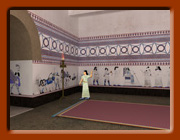 Our educational package exploring the Assyrian palace at Til Barsip (Syria), the city's Lion Gate, and temple was specially created to integrate into existing classroom activities.
Our educational package exploring the Assyrian palace at Til Barsip (Syria), the city's Lion Gate, and temple was specially created to integrate into existing classroom activities.
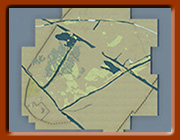 Our elementary school educational module, based on the Old Babylonian urban center of Mashkan-shapir, was designed to teach about the nature of ancient water-based commerce, sectoring of cities based on function, and the massive scale of ancient cities.
Our elementary school educational module, based on the Old Babylonian urban center of Mashkan-shapir, was designed to teach about the nature of ancient water-based commerce, sectoring of cities based on function, and the massive scale of ancient cities.
Archaeologists, often stymied by the inability to disseminate all their excavated data or frustrated by the high cost of publishing color images, are turning to us to help them create all-digital excavation reports, visualizations for interim Websites and social media outlets, and preliminary or supplemental online publication supplements.
LEARNING SITES can integrate and publish your excavated evidence, analyses, images, databases, and even notebook pages as a comprehensive, hyperlinked, electronic monograph. We'll collaborate with you to help you understand your evidence interactively, in 3D, and in color (just like the past actually happened). Our approach has proven to produce significant new insight into site history, architectural chronology, and cultural activities. LEARNING SITES also will produce stunning 2D and 3D visualizations of your artifacts, structures, or complete sites that will assist you to prepare your material for publication, for teaching, or for conference presentations.
For Example:
Tsoungiza, Ancient Nemea, Greece, Neolithic-Bronze Age settlement. This electronic publication will include all the data from the excavations, virtual reality re-creations of the trenches
with 3D artifacts in their excavated contexts, and a searchable database linked to virtual worlds, photos, drawings, and text.
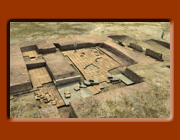 Nimrud, Central Palace Area, various palaces across the 9th-8th centuries BCE. This all-digital publication will include all the unpublished data from the excavations, field notebook data, linked virtual worlds, and all the photos and drawings taken during the dig seasons.
Nimrud, Central Palace Area, various palaces across the 9th-8th centuries BCE. This all-digital publication will include all the unpublished data from the excavations, field notebook data, linked virtual worlds, and all the photos and drawings taken during the dig seasons.
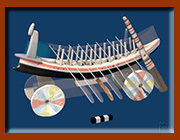 The Gurob ship model project created an online digital module to supplement the paper publication, to provide high-resolution color images, to provide researchers with interactive 3D models of various iterations of the ship, and to provide additional background images and narrative better suited to the digital realm.
The Gurob ship model project created an online digital module to supplement the paper publication, to provide high-resolution color images, to provide researchers with interactive 3D models of various iterations of the ship, and to provide additional background images and narrative better suited to the digital realm.
LEARNING SITES creates scholarly research materials from data generated by archaeologists, architects, and art historians to help resolve complex hypotheses. We work closely with experts on each site, painstakingly sifting through excavated data, early travelers' drawings and descriptions, and recent analyses to create massive reports that use virtual worlds as the visual index to all the information. Our unique interactive compendia offer a single resource for research on individual sites or large buildings.
LEARNING SITES' virtual reality re-creations of sites, buildings, and individual artifacts allow researchers to understand complex historical issues in ways impossible using traditional visualization techniques. Working directly with archaeologists to build our interactive 3D environments has led to many new insights into such subjects as ancient construction techniques, the function of spaces, and the understanding of decorative programs too cumbersome to study using conventional means.
For Example:
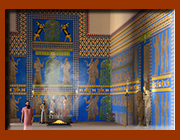 Northwest Palace of King Ashur-nasir-pal II, Nimrud, Assyria, 9th
century BCE.
Northwest Palace of King Ashur-nasir-pal II, Nimrud, Assyria, 9th
century BCE.
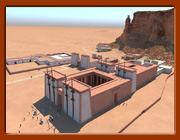 Jebel Barkal, Nubia, the entire site comprising dozens of temples and palaces and thousands of years of history.
Jebel Barkal, Nubia, the entire site comprising dozens of temples and palaces and thousands of years of history.
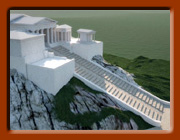 The Acropolis, Athens, Greece, 5th century BCE.
The Acropolis, Athens, Greece, 5th century BCE.
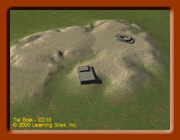 Tell
Brak, Syria, settlement, 3rd millennium BCE.
Tell
Brak, Syria, settlement, 3rd millennium BCE.
LEARNING SITES puts museum objects back into digital simulations of their original cultural contexts. Our visualizations inform the public about your exhibition as a whole, supplement your stories, and excite and dazzle visitors. From continuously running animations to fully interactive virtual worlds or projected immersive experiences, your museum exhibitions can be enhanced and visitor numbers increased through the addition of accurate, detailed, and high-resolution multimedia solutions created by LEARNING SITES.
Our visualizations educate and enthrall visitors of all ages. Some of our museum clients include: the British Museum (London); the Louvre (Paris); the Rijksmuseum van Oudheden (Leiden); the Metropolitan Museum of Art (NYC); the Denver Art Museum; the Ashmolean Museum (Oxford); the Hood Art Museum (Dartmouth College); the Williams College Museum of Art (Williamstown MA); the Dallas Museum of Art; the Miho Museum (near Kyoto); the Bible Lands Museum (Jerusalem); the Semitic Museum (Harvard University); the Petrie Museum (London); the University of Pennsylvania Museum of Archaeology.
For Example:
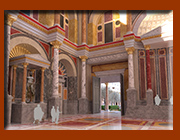 Palace of the Emperor Domitian, Rome, 1st c. CE. Our annotated animations of the emperor's palace and childhood home were displayed at the Rijksmuseum van Oudheden (Leiden), projected onto walls for immersive experiences, and filled entire galleries with renderings of key spaces.
Palace of the Emperor Domitian, Rome, 1st c. CE. Our annotated animations of the emperor's palace and childhood home were displayed at the Rijksmuseum van Oudheden (Leiden), projected onto walls for immersive experiences, and filled entire galleries with renderings of key spaces.
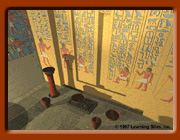 Funerary Chapel of Ka(i)pura, Saqqara, Egypt, c.2415-2298 BCE. Our narrated animation toured several museums across the United States for over two years with a large exhibit of objects from the University of Pennsylvania Museum of Archaeology and Anthropology.
Funerary Chapel of Ka(i)pura, Saqqara, Egypt, c.2415-2298 BCE. Our narrated animation toured several museums across the United States for over two years with a large exhibit of objects from the University of Pennsylvania Museum of Archaeology and Anthropology.
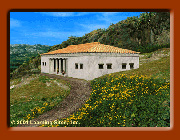 Paliké,Catania, Sicily, hestiaterion (dining hall), 5th century BCE. The hestiaterion virtual world is displayed at the excavation site visitors' center for public access.
Paliké,Catania, Sicily, hestiaterion (dining hall), 5th century BCE. The hestiaterion virtual world is displayed at the excavation site visitors' center for public access.
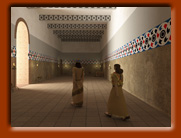 Northwest Palace of King Ashur-nasir-pal II, Nimrud, Assyria, 9th
century BCE. Two museum installations at the Hood Museum of Art (on display throughout 2006) and the Williams College Museum of Art (on display since 2010) proved highly successful, integrating high-resolution flyovers with interactive virtual reality. A further elaboration of the flyover was part of a larger exhibition at the Metropolitan Museum of Art, NYC (during 2015).
Northwest Palace of King Ashur-nasir-pal II, Nimrud, Assyria, 9th
century BCE. Two museum installations at the Hood Museum of Art (on display throughout 2006) and the Williams College Museum of Art (on display since 2010) proved highly successful, integrating high-resolution flyovers with interactive virtual reality. A further elaboration of the flyover was part of a larger exhibition at the Metropolitan Museum of Art, NYC (during 2015).